Warm floor in the bath: a comparative overview of heating systems when installing in the bath room
Most often, wooden floors are laid in saunas. This is due to the fact that the tree has low thermal conductivity and it is nice to step on it with bare feet. But for the foundation, choose a mixture of concrete with crushed stone or pure concrete. This is due to the fact that concrete is stronger and does not respond to climate change like a tree. But concrete has high thermal conductivity, which leads to heat loss. And this entails a quick cooling of the floor. Therefore, in order for visitors to be comfortable, it is necessary to build a warm floor in the bathhouse or to insulate the existing coating.
In modern construction, floor insulation in the bathhouse is performed using expanded clay, felt, basalt and glass fiber mats and other materials. The material is placed between two layers of concrete. If the floor is equipped with lags, then between the lags. Usually the thickness of the insulating layer does not exceed 15 cm. If desired, it can be made thicker. The use of expanded clay to warm the floors in the bath creates additional ventilation. At the same time, do not forget about additional waterproofing.
Arrangement of the "warm floor" system in the bathhouse
In some cases, warming the floor of the bath does not give the desired result. Then resort to the installation of underfloor heating. There are two types of underfloor heating:
- water, works on the same principle as radiators;
- electric, which by the principle of heating happens: convection and infrared, according to design: film, cable, rod.
Option # 1 - water floor heating
To arrange water heated floors use steel, polyethylene or metal-plastic pipes. Such a construction consists of pipe wiring, which is located between the base and the floor covering. As a coolant, you can use not only water, but also special solutions, antifreeze, ethylene glycol.
To prevent the loss of heat, pipes are laid on the insulating material. And to ensure more efficient heat transfer - also on aluminum foil. There are two ways of laying distributing pipes - “snake” and “snail”. The first is easier to install. The second allows the heating element to evenly distribute throughout the system.
Installation of the "warm floor" system in a wooden house allows you to fully use the usable area and not clutter up the room with metal batteries. We will tell about which system to choose and how to mount it in the article:https://floor.techinfus.com/en/tepliy-pol/teplyj-pol-v-derevyannom-zagorodnom-dome.html.
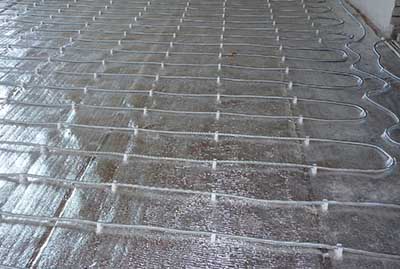
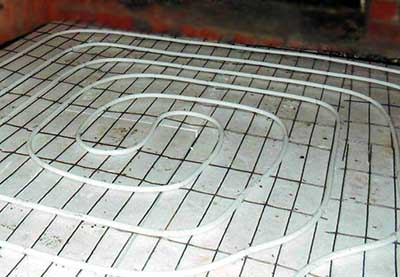
Several options for water heating are possible:
- Installation of underfloor heating on a wooden base.
- Pipe wiring installation followed by concrete pouring.
- The use of polystyrene plates with grooves in which pipes are laid.
Advantages of the water system:
- the heating system is hidden from view;
- the ability to heat a large area at low cost;
- uniform distribution of heat over the area of the room;
- unlike an electric floor, energy savings.
Its disadvantages:
- installation complexity;
- the need for a water pump;
- the complexity of temperature regulation;
- difficulty in detecting leaks in case of leakage.
It is possible to equip a warm floor in rooms with tiled tiles. Learn how to do this for different types of equipment in the material:https://floor.techinfus.com/en/tepliy-pol/teplyj-pol-pod-plitku.html.
Option # 2 - electric floor heating
When arranging an electric underfloor heating, be prepared for additional waste of electricity. However, such floors have a number of positive aspects. Let's look at the main options for systems running on electricity.
Convection Cable Floor
Convection cable underfloor heating is made of a heating cable laid on a mesh base. Such a warm floor is sold in rolls. Laying such a floor is a rather complicated process, which is desirable to entrust to the masters.
Advantages: automatic temperature control + suitable for any floor covering. Disadvantages: dependence on energy supply and additional waste of electricity.
Film infrared system
Infrared radiation in its range is identical to the sun. But much better, since it does not have the harmful effects of ultraviolet radiation. The film electric floor is made of thin (0.3 mm) flexible strips. And they consist of a carbon material firmly sealed in a polymer film.
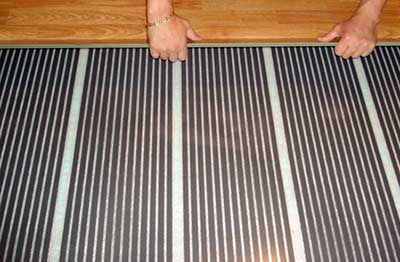
Equipping a film heat-insulated floor in the bath, heat-reflecting material (isolon) is placed on the base. Elements of a warm floor are laid out on it, and a plastic film on top. It is necessary for waterproofing heating elements. The final step is installing the floor covering.
Advantages of the system:
- with proper installation, the failure of the system is excluded;
- since the elements are connected in parallel, the failure of one segment will not affect the others;
- infrared radiation is used in film elements, and it is useful for humans;
- lack of electromagnetic radiation;
- Possibility of laying under heavy flooring, such as ceramic tiles and porcelain tiles.
The disadvantages include low moisture resistance, which is why such a floor is not very suitable for rooms with high humidity.
Rod infrared
Rod infrared elements are called mats. In them, heating elements are rods connected to the supply wires. Since the connection is parallel, failure of one element will not entail failure of the rest. In appearance, infrared mats look like a rope ladder. Mount such floors in a cement screed or in tile adhesive.
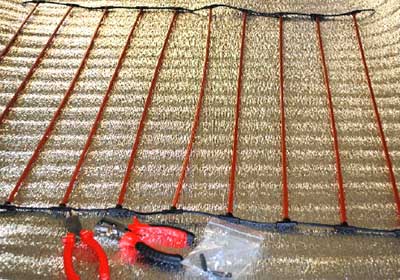
Benefits:
- does not generate electromagnetic radiation;
- not afraid of "locking" with furniture;
- not afraid of overheating.
Disadvantages: dependence on energy supply and high cost.
You can read more about film infrared warm field here:https://floor.techinfus.com/en/tepliy-pol/plenochnyj-infrakrasnyj-teplyj-pol.html. System overview and installation technology.
How to cover warm floors after installation?
When equipping a warm floor in your bathhouse, you should not forget about the importance of installing a topcoat. Not only the aesthetic appearance of the room, but also the sanitary condition depends on this. As a floor covering for a bath, you can use:
- ceramic tile, it has good thermal conductivity, is not afraid of temperature changes, is easy to clean, it has a long service life;
- parquet coating, when processing with protective equipment, laying in the dressing room is possible;
- laminate, suitable for arranging lightweight floors;
- linoleum, only with anti-slip coating, the cheapest option.
Any design of underfloor heating and advantages and disadvantages. Knowing them, you can make an informed choice. The device of the water system allows you to save on payment for electricity. Heating a fairly large area will not entail tangible waste.
In this case, the heating elements will not be visible. But you have to get a pump for forced circulation of water through pipes. And eliminating the leak will take a lot of time and effort. Electrically heated floors are easier to install and operate. But they depend on energy supply and increase waste for electricity.

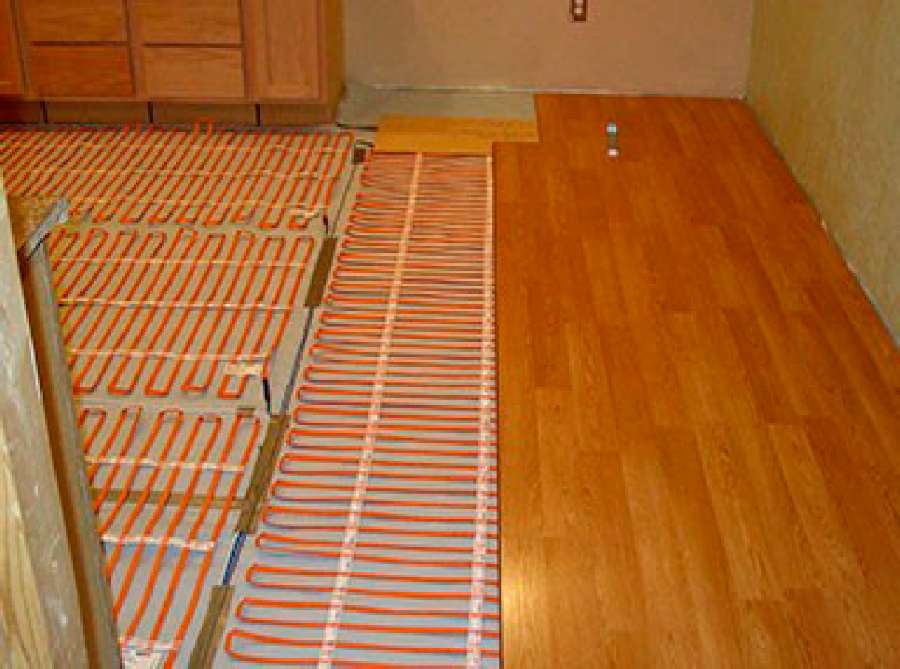
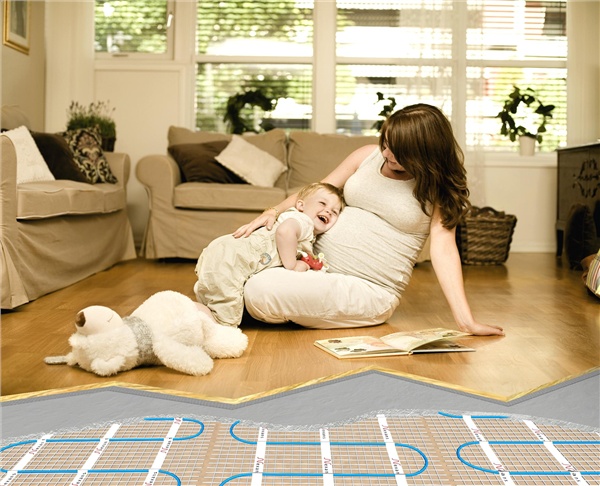
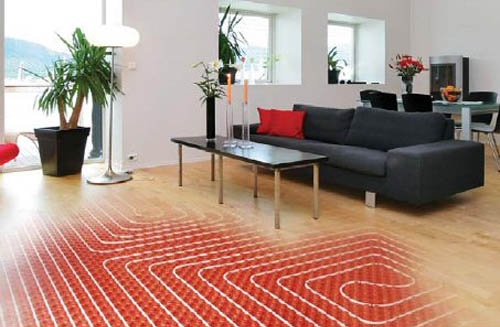
3 comments